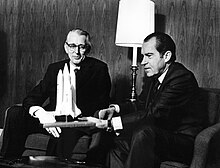James C. Fletcher
James C. Fletcher | |
|---|---|
President of the University of Utah | |
| In office 1964–1971 | |
| Preceded by | A. Ray Olpin |
| Succeeded by | Alfred C. Emery |
| Personal details | |
| Born | June 5, 1919 Aerojet General |
| Thesis | Cloud chamber studies of cosmic rays (1948) |
| Doctoral advisor | Carl David Anderson |
James Chipman Fletcher (June 5, 1919 – December 22, 1991) served as the 4th and 7th Administrator of
Biography


Fletcher was born in
During his first administration at NASA, Fletcher was responsible for beginning the Space Shuttle effort, as well as the Viking program that sent landers to Mars. He oversaw the Skylab missions and approved the Voyager space probes and the Apollo–Soyuz Test Project.
When he left NASA in 1977, Fletcher became an independent consultant in McLean, Virginia, and served on the faculty of the University of Pittsburgh. For nine years, he was active as an advisor to key national leaders involved in planning space policy. Among other activities, he served on an advisory board involved in developing the Strategic Defense Initiative.
In 1986, President Ronald Reagan selected Fletcher to administer NASA for a second time, to help the agency recover from the Space Shuttle Challenger accident. Shuttle flights went into a two-year hiatus while Fletcher ensured that NASA reinvested heavily in the program's safety and reliability, made organizational changes to improve efficiency, and restructured its management system. He oversaw a complete reworking of the components of the Shuttle to enhance its safety, including a redesign of the solid rocket boosters, and added an egress method for the astronauts. The Space Shuttle returned to flight on September 29, 1988. Fletcher also approved the Hubble Space Telescope program. He served as Administrator until April 8, 1989, into the term of Reagan's successor, President George H. W. Bush.
Fletcher lived in
In 1974, he received the Golden Plate Award of the
References
- ^ "In Memory of Harvey Fletcher". www.et.byu.edu. Brigham Young University. Retrieved 24 April 2019.
- .
- ^ a b Fisher, Ian (December 24, 1991). "James Fletcher, 72, NASA Chief Who Urged Shuttle Program, Dies". The New York Times. Retrieved December 11, 2007.
- American Academy of Achievement.
- ^ "5 Inducted Into Space Hall of Fame". El Paso Times. El Paso, Texas. Associated Press. October 5, 1992. p. 8 – via Newspapers.com.
Sources
- Portions of this article are based on public domain text from NASA
External links
 Media related to James C. Fletcher at Wikimedia Commons
Media related to James C. Fletcher at Wikimedia Commons- Appearances on C-SPAN
